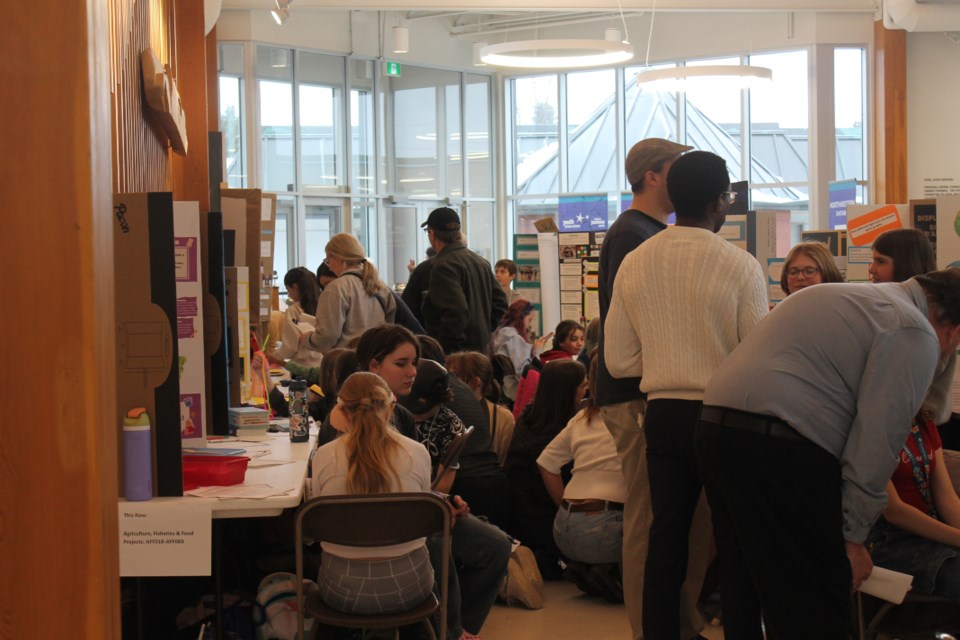THUNDER BAY — From climate change to microplastics, students were showing their knowledge at the Northwestern Ontario Regional Science Fair, on Wednesday.
At Confederation College’s TEC Hub, local students from Grade 4 to 12 exhibited their very own STEM projects.
“A child comes up with their own project idea. They follow the scientific method they're trying to prove . . . and then today, they are the teachers,” said Rebecca Cross, co-chair for the Northwestern Ontario Regional Science Fair (NORSF).
There was a team of judges from Thunder Bay and a few from Ignace, who were taught by the students about their science, she added.
“The students compete at the school level first, and then the top students from those schools then come on here to compete. Our top six projects from Grades 7 to 12 then get to go on and compete at the national fair,” Cross said.
There were about 90 projects on display. Due to weather conditions, students from other parts of the region were unable to attend in-person, and instead competed virtually.
“We had 13 or 14 students who are competing virtually. We cover the region from Marathon all the way to the Manitoba border.
“They all qualify for prizes as well. Because our region is a little bit unique in that we are a very big region, (we don’t) expect a student from Kenora or Sandy Lake to drive down for a day. Thanks to technology, we can offer a hybrid format,” she said.
Every student must follow the scientific method, and there are safety and ethics protocols that must be followed as well.
“It's preparing (students) for going on to post secondary education,” she added.
Cross said AI is a new factor in the fair this year, and judges will be asking questions about how students used AI in their projects.
Dhruv Ayare, Grade 10 student at St. Ignatius High School, submitted his project on how anthropogenic clouds can help slow down the effects of climate change.
“I had a cloud generator that creates clouds out of propylene glycol and vegetable glycerin where there's a heat side up. It creates a mist out of that, and I put that cloud inside of an acrylic box that was completely closed off. That acrylic box went underneath the heat lamp.
“The heat lamp heated up the ground underneath it, and I measured the temperature below to see the effects, like how much heat can that cloud reflect,” Ayare said.
Ayare found that the clouds had a substantial effect on the amount of heat that was getting through.
“I'm surprised at how little cloud you need to reflect a lot of heat,” he said.
Payton Grimard, Grade 6 student at Elsie MacGill Public School, centred her project on pollution.
“There are three main types of pollution – water, air, and land," she said.
“The main one is water. That mainly affects our coral growth and reproduction of all of our animals. Air, which affects us through our respiratory system and it causes some diseases: cancer, respiratory diseases, and then there's land, which affects mostly soils and destroys all of our forests."
Grimard said she found that animals don’t see plastic as what it is.
“They will eat it thinking it's food, so it will get caught in their digestive system and eventually kill them,” she said.
She said finding reputable information was one of her biggest roadblocks.
Gabriela Blandon, Grade 10 student at St. Ignatius High School, based her project on research determining if any effects on plant growth would result from microplastics present in the soil.
“I decided to research if any microplastics were present in agricultural soils right now in Southern Ontario. There were microplastics present in the soil, so that was my first concentration level.
“Then I just kept increasing the amount to simulate what would happen in (future) decades, of not controlling the amount of microplastics that would be going into the soil. I measured the length of my plants. There were 27 plants per concentration level for 20 days then I measured their length, their health, I would see how many of them would survive and how many of them would germinate in a certain amount of time,” she said.
Blandon did not find any correlation between microplastics and lower germination and survival rates, but in terms of the growth, she found they did grow slower.
“It was a significant amount, six millimetres shorter than the ones with no microplastics,” she said.
